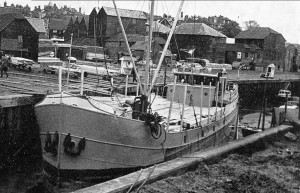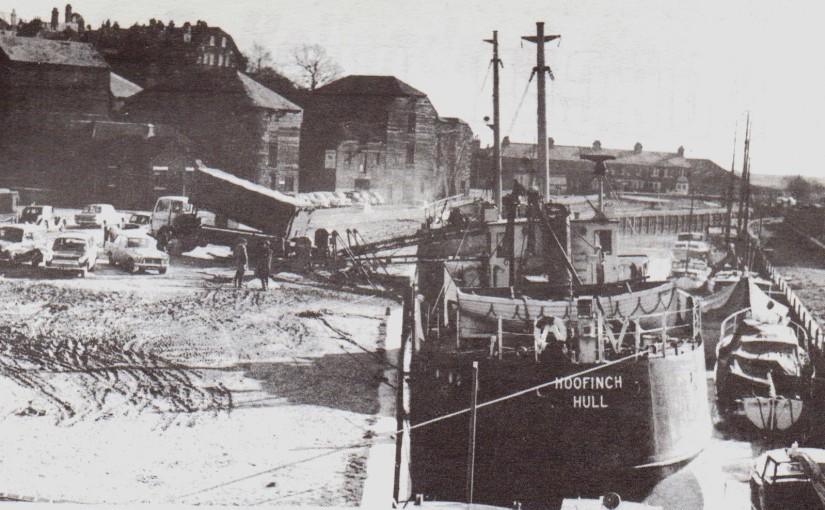PORT COMMERCE
By Nan King
Before the last war, Rye Harbour played a small role as a port used mainly for coast-wise shipping of materials for domestic and industrial purposes. Large quantities of shingle were shipped to the north of England and Scotland, and cargoes of pitch went to the Continent. Coal came from Newcastle, and granite c hippings arrived from the West Country for utilisation in the manufacturing of concrete. Understandably, there was a decline in the use of Rye Harbour following the war, and for many years, only one or two small timber boats would call at Rye each year. However, since the completion by Alsford Ltd., timber merchants, of a new wharf early in 1968, Rye Harbour has taken on a new lease of life.
The wharf has a frontage of some 600ft. and is capable of taking up to three vessels at one time of up to approximately 6/700 tons; when tides are favourable, boats as large as 700 tons have been able to use the harbour quite safely. Additional work has also been carried out on deepening parts of the River Rother to make it more easily navigable. Prior to the opening of this larger wharf, Rye could only cope with one large vessel at a time, with a maximum of only 300 tons, at the old-established Strand Quay. However, since June, 1968, sixteen ships have used the harbour’s much improved facilities, and from comments received from satisfied customers, substantial increases in the number of ships calling at Rye might be expected in the years ahead.
At present, shipping is involved in a mini-boom due to recent heavy increases in road haulage and rail rates, and comparatively stable shipping rates, making shipping the cheapest form of transport per mile available for bulk loads.
With more use being made of the harbour, expansion of many businesses in and around Rye has become apparent, particularly those involving seamen, engineers, ship owners, insurance work, and even the appearance of a tug. Agency work, which is undertaken to a large extent in Rye by Rye Shipping Ltd., is important in that it provides a service for the captain and his crew and may involve a variety of things from making arrangements for repairs, etc., to the ship; re-fuelling (average vessels calling at Rye may have fuel tanks for approximately 20 tons of diesel, as consumption of fuel when sailing, may be in the region of two tons a day); arranging for ship’s laundry: stocking up with food for continuing the journey; and it may include visits to a local doctor for vaccinations, etc. Rye Shipping also undertake the chartering of ships which involves liaison work to fix a specific vessel to ship a certain cargo from one port to another, the drawing up of official documents, etc. Thus, with the addition of new faces to Rye which have included Dutchmen, Swedes, Germans, Poles and Portuguese—the latter from Swedish boats—additional revenue has been realised by the towns people of Rye.
Piloting is another service provided by the harbour to ensure a safe passage of the vessel in and out of the harbour. A qualified man, termed a Trinity House pilot, is taken out by launch to the ship which will generally lie some three miles out due south of the harbour entrance, where the pilot goes on board and guides the ship’s captain into port. Piloting can be hazardous depending upon weather conditions and is unlikely to be undertaken if winds are above Force 7.
Customs clearance is another procedure taken on by the agency to facilitate communications between customs officials and the ship’s captain. However, communications with foreign boats is no great problem as, Britain having been renowned in ages past as the greatest trading nation, all shipping chartering, transactions, etc., are carried out in English and the majority of foreign owners and skippers speak excellent English.
An interesting point to note is that if a vessel has encountered bad weather during its journey, the captain of the ship is entitled on reaching port, to protest before the local magistrates against the dangers of the sea, thus absolving the ship and crew from any liability against loss or damage of the cargo, or delay in arrival. Also of interest is that nearly all ships calling at Rye have a pet on board, which is very often a dog.

Rye’s recent imports have mainly been in the form of timber from Sweden and Finland, the majority of which is softwood, for the building trade, and is imported by Messrs. J. Alsford Ltd. and Messrs. Thomas Hinds. Rye has also seen the import of seaweed fertilisers from France and chemical fertilisers from Holland, which is sold on through local merchants to farmers.
Exports out of Rye are playing their part in aiding the country’s balance of payments and have recently included local consignments of agricultural products. Quantities of English feeding barley and oats have been shipped to Belgium and Holland, mostly to be utilised as cattle foodstuffs: also cargoes of Tic beans to Germany for the same purpose. Local good quality straw has gone to the Channel Islands, where cultivation of tomatoes and mushrooms is carried out on an intensive scale, and a quantity of hay for feeding livestock has also found its way to these islands.
Using Rye Harbour for coastwise shipping carries great potential, due to the already mentioned increase in road haulage rates in Britain. granite chippings may come from the West Country; seed potatoes from Scotland and Northern Ireland; and slag from Wales is being shipped into Rye for use in building the new sewage developments at Guestling and Winchelsea. There is a possibility of sand coming into Rye from Colchester which, to comment cripticallv, might be described as “carrying coals to Newcastle!”
The future for Rye Harbour should be bright following a general trend of increased popularity for smaller pods in the British Isles, examples of such might include Shoreham. Whitstable and Colchester, in addition to Rye. The reason for this lies in the fact that smaller ports can offer a quick “turn-round’ in comparison with larger ports such as London or Liverpool, where labour relations are said to be poor thus causing unwanted delays to ships and cargoes, in addition to which, port costs at smaller harbours are substantially less. Baltic timber shipping companies who used Rye last summer have already written to say how satisfied they have been with the service afforded at Rye Harbour and have stressed a desire for repeat cargoes this year.
It has been commented upon that, to a certain extent, it is immaterial how much money is spent by shipping companions, etc., in bringing trade to the harbour (excluding such facts as the vast improvements made by J. Alsford’s new wharf) but that the future of Rye Harbour’s success depends on the cargo men of Rye who discharge or load the ships’ cargoes, enabling the all important quick “turn-round”, to continue the very excellent work that they have shown us they are capable of doing. An example of this fine work was seen recently when a ship’s captain expressed a wish to get his crew home in time for Christmas, and as a result, 500 tons of Baltic timber were discharged in 25 working hours by a small working force of cargo men, thus making it possible to accommodate the captain. Surely it is achievements such as these that must hold the key to the buoyancy of Rye Harbour as a thriving port in the years ahead.
Rye’s Own February 1969
All articles, photographs and drawings on this web site are World Copyright Protected. No reproduction for publication without prior arrangement. © World Copyright 2015 Cinque Ports Magazines Rye Ltd., Guinea Hall Lodge Sellindge TN25 6EG
